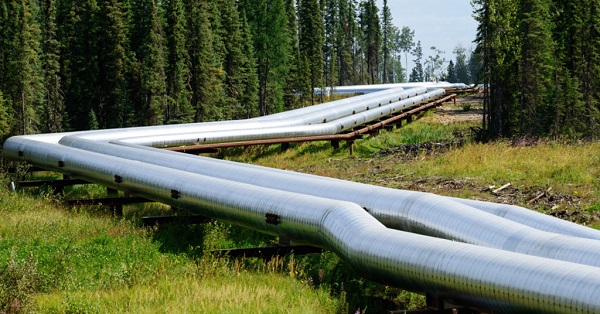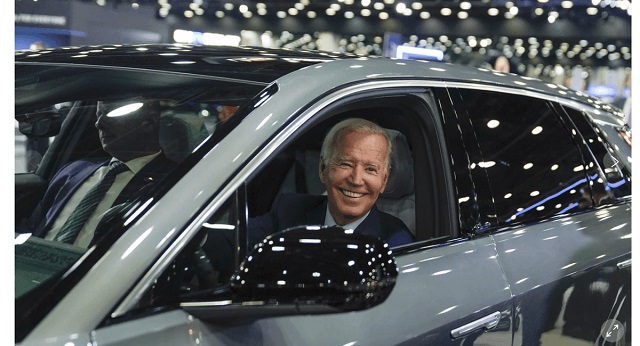Energy
Free Speech Was Curtailed In Canada. Did You Notice?

From the Frontier Centre for Public Policy
We’ve seen this before, of course… The Soviets under Lenin and Stalin, and Maoists in China made denunciation commonplace. Don’t like someone? Denounce them for anti-revolutionary speech and have them hauled off to the gulag for 10 years
In the waning days of June, the federal Liberal government, supported by the New Democratic Party, passed legislation to take away some of the rights to free speech in Canada.
Bill C-59 was an omnibus budget bill, which meant its passage was assured lest the government fall. And there are some amendments to the Competition Act within C-59 which are effectively a gag law for you, me, and everybody else.
Gag law
I honestly wasn’t aware of it until Minister of Justice and Attorney General Bronwyn Eyre held a press scrum at the Saskatchewan Oil and Gas Show on June 5 to talk about this. She called it a “gag law,” and it has become evident those were very fitting words.
The additions to the budget impact the Competition Act, for the purpose of eliminating “greenwashing.” The significant clauses state:
“A person engages in reviewable conduct who, for the purpose of promoting, directly or indirectly, the supply or use of a product or for the purpose of promoting, directly or indirectly, any business interest, by any means whatever …
“(b.1) Makes a representation to the public in the form of a statement, warranty or guarantee of a product’s benefits for protecting or restoring the environment or mitigating the environmental, social and ecological causes or effects of climate change that is not based on an adequate and proper test, the proof of which lies on the person making the representation;
“(b.2) Makes a representation to the public with respect to the benefits of a business or business activity for protecting or restoring the environment or mitigating the environmental and ecological causes or effects of climate change that is not based on adequate and proper substantiation in accordance with internationally recognized methodology, the proof of which lies on the person making the representation.”
The penalties for a corporation can be up to three per cent of global revenue.
Charlie Angus’ influence
The Bill was introduced last November, but these portions were amended since then. And you can see from a briefing submission from the environmental lobby, some of their suggestions were implemented.
It also seems to be an extension of Charlie Angus private members bill, which was banning the promotional petroleum in early February. I think that was a trial balloon. No one really thought anything would come of it, but the essence of that bill was already in Section 236 of C-59, with amendments made at the very end of the budgetary process.
This move seems to be a back-door implementation of NDP MP Charlie Angus’ private members bill, Bill C-372, which sought to shut down all oil and gas advertising. Angus’ press release said, “Passage of Bill C-372 will mean that no fossil fuel company will be able to advertise, promote their products, nor mislead the public about the health and environmental threats posed by the burning of fossil fuels, which the World Health Organization now says is the biggest global health threat of the 21st century.”
Isn’t that eerily similar to the clauses noted above?
Saskatchewan calls it a gag law
Eyre told reporters on June 5, “This is a gag law. It’s a federal gag law. It’s Charlie Angus’ fossil fuels advertising act in another form, and it is very serious. That’s what the letter expresses, our profound alarm at this rushed bill, Bill C-59, which is part of an omnibus budget bill. It was rushed, it was done without consultation with any of the provinces. And it could have a very profound effect, very sobering effect harmful effects on our economy, frankly, so very, very concerned about C-59.”
Premier Scott Moe posted on social media on July 2, “It’s a wonder why the federal government would want to put a gag order on Saskatchewan oil and gas companies when they are having great success with their emission reductions. In fact, our energy sectors greenhouse gas emissions last year were 67 per cent below levels reported in 2015. Our government will continue to fight against the Liberal-NDP Coalition Bill C-59 plan in order to protect Saskatchewan’s energy sector.”
Such a statement, made by a provincial premier, no less, could possibly be considered afoul of the law, if he had made these statements after June 20, 2025, when the law is implemented.
Did Moe quote “proper substantiation in accordance with internationally recognized methodology?” After all, according to the law of the land now, “the proof of which lies on the person making the representation.”
It’s a wonder why the federal government would want to put a gag order on Saskatchewan Oil and Gas companies when they are having great success with their emission reductions.
In fact, our energy sectors greenhouse gas emissions last year were 67 per cent below levels reported… pic.twitter.com/FEHFM9CQsb
— Scott Moe (@PremierScottMoe) July 3, 2024
Jordan Peterson persecution
The implementation of this law is essentially modelled on the persecution (and I don’t use that term lightly) of Dr. Jordan Peterson.
As noted by the National Post, Dr. Peterson’s plight was that the “College of Psychologists of Ontario that ordered Jordan Peterson into a mandatory rehabilitation program for his politically incorrect tweets, which had nothing to do with his practice and involved none of his patients.”
Among the complaints made against him was the submission of the entire transcript of his appearance on the Joe Rogan Experience podcast! And an Ontario court backed up the College’s prosecution (persecution?) of him!
Bill C-59 conjures up a similar system. As energy advocate Deidra Garyk writes in Pipeline Online, “While focus has been on the muzzling of oil and gas supporters and companies, this bill is agnostic and, therefore, allows all industries to be targeted. Although, oil and gas is likely to be disproportionately aimed at and penalized since anyone can go onto the Bureau’s website and easily complete a complaint form. You do not have to be a victim to file a complaint, meaning a company can be accused of a victimless crime.”
Communist-style denunciation
We’ve seen this before, of course, long before Peterson’s problems. The Soviets under Lenin and Stalin, and Maoists in China made denunciation commonplace. Don’t like someone? Denounce them for anti-revolutionary speech and have them hauled off to the gulag for 10 years, but only if they don’t catch a bullet behind the ear, first.
Process is the punishment
While Canadians aren’t likely to catch a bullet, yet, this is a situation where the process is the punishment. It doesn’t matter if the complainants win. All they have to do is initiate the process, and you are in a world of hurt.
And trust me, they will be filing complaints. Expect groups like Ecojustice, Sierra Club, and Greenpeace to be lining them up as we speak. In December, several of them, including Ecojustice, submitted a briefing note “amending Bill C-59 to more effectively combat greenwashing.”
A few clicks online and bam! You’re tied up in litigation that’s from tens to hundreds of thousands of dollars.
And even if you win, you still lose, because you’ve paid all that money for the lawyers and the time and effort.
And in the meantime, while you’re in litigation, you’re not going to say a damn thing until it’s resolved. So, you have effectively been muted until the court process, which is never quick and efficient, is dealt with. Again, the process is the punishment.
Easier to say nothing, ever
Now, the solution for most people, and most companies, will realize is that it’s easier not to say anything at all, which effectively silences you. As Eyre said, this is a gag law.
And you know what really, really troubling?
Some of the largest companies in Canada, corporations with literally floors of lawyers among them, folded like a house of cards as soon as C-59 became law. The Pathways Alliance, made up of the six largest oilsands producers, promptly wiped their website clean. The Canadian Association of Petroleum Producers, on June 20, said it “has chosen to reduce the amount of information it makes available on its website and other digital platforms until the Competition Bureau has released further guidance on how these amendments will be implemented.”
So the gag has been thoroughly applied, already. Spines, and perhaps some other bodily parts, are notably absent.
And these are the organizations with by far the largest resources to fight this assault on free speech. Instead, they issued press releases. Big deal. That press release should have said they will fight this tooth and nail. Instead, They’ve already all but given up.
So what the hell am I supposed to do, working in my basement as a one man band? I have no financial resources to pay for any sort of legal fight.
How the hell am I supposed to fight this when the people who have all the resources in the world, in this country have said, “Oh, we’ll put up a press release saying, ‘We don’t like this, but we’re not going to do anything about it.’”
I’ll tell you what my defence is, should I, or my corporation, Pipeline Online Ltd., have a complaint issued under this legislation: Section 2(b) of the Canadian Charter of Rights and Freedoms. It states, “Everyone has the following fundamental freedoms: (b) freedom of thought, belief, opinion and expression, including freedom of the press and other media of communication.”
That includes the right to say whatever you want about “protecting or restoring the environment or mitigating the environmental, social and ecological causes or effects of climate change.”
And under Canadian law, corporations have rights, too.
ESG as the rope to hang you
And here’s another twist: in the last four years, environment, social and governance, or ESG statements or reports have went from non-existent to required if you expect any sort of institutional investment. No ESG report; no money, honey.
But these very reports, the ones making companies’ environmental cases, will now be rope with which the likes of Ecojustice and Greenpeace will hang them. Now if you publish an ESG statement, your critics can use that as evidence to prosecute you. So you’re damned if you do, and you’re damned if you don’t. If you don’t put out an ESG statement, maybe you’ll lose all your investors. And if you do publish it, well, maybe you’ll get prosecuted by this for saying the wonderful stuff that you have tried to do for the environment.
What if a journalist like me comes around and does a story on your company? Let’s give a real example. Several years ago, a drilling company which no longer exists called CanElson converted many of it rigs to operate on dual-fuel; diesel and compressed natural gas. And one of the reasons cited at the time when I wrote about it was the environmental benefits from lower emissions. But now, lawyers would almost certainly tell them everything they say would have to be couched with “proper substantiation in accordance with internationally recognized methodology.” In other words, mountains of fine print. But no press organization is going to publish all of that, and the company would have no control over what is published. So that company’s lawyer would, according to the new law, obviously advise their clients to say nothing, ever, to any media where it could be published, lest they open themselves up to prosecution under the Competition Act, as amended by Bill C-59.
Again, a gag law.
1984
This is really an implementation of George Orwell’s 1984, where groupthink has been legislated into law a couple week ago by the federal government. If you say anything against the current orthodoxy of anthropogenic climate change, or even if your efforts to support it are found insufficient, you are an apostate and can be prosecuted for it.
This is not hyperbole. This has really happened.
Your freedom of speech, today, is dramatically reduced from what it was on June 19.
And we allowed it to happen.
Authoritarian pattern
This reminds me of how the Russian Revolution evolved under the Soviets, as recorded by Aleksandr Solzhenitsyn’s The Gulag Archipelago. First they came for the Mensheviks, then the socialists. Then they came for the bourgeois business owners and clergy. Next were the engineers, which were called “wreckers,” as well as the intelligentsia. Then they came for the kulaks, which were farmers who had as few as three cows, leading to the Holodomor. Then they came for the military, in the great purge.
This is the route authoritarianism takes. Free speech is the first to go. What comes after that?
I’ve been talking to a number of people about this in recent weeks. Some have suggested working within the system as it now exists, under the new changes to the Competition Act. Some have suggested using the new rules to fight back, making complaints about the green lobby, instead.
That’s a fool’s errand. You’re co-opting the authoritarians’ plan. Just like the Jews who dutifully donned their yellow Stars of David. If we just do what they tell us to, work within their new rules, maybe they’ll leave us alone.
How did that work out?
I wore a uniform as a reservist officer in the Canadian Forces. I may have been the lowest form of reservist officer, but I still wore a uniform for seven years, and there’s no way in hell I am going to be gagged by my own federal government for being able to say what I’m going to say.
And the fact that CAPP and the Pathways Alliance folded on this like a cheap house of cards, is all the more troubling. They’ve just been handed the environmental equivalent of a yellow star, and they dutifully put it on.
Will you do the same?
Brian Zinchuk is editor and owner of Pipeline Online, and occasional contributor to the Frontier Centre for Public Policy. He can be reached at [email protected].
Dan McTeague
Will this deal actually build a pipeline in Canada?

By Dan McTeague
Will Carney’s new pipeline deal actually help get a pipeline built in Canada? As we said before, the devil is in the details.
While the establishment and mainstream media cheer on the new pipeline agreement, there are specific details you need to be aware of.
Dan McTeague explains in his latest video.
Energy
Canada following Europe’s stumble by ignoring energy reality

Family in Spain eating by candlelight during a blackout, April 2025
From Resource Works
Canada’s own 2024 grid scare proves we’re on the same path unless we change course.
Europe’s green-energy unraveling is no longer a distant cautionary tale. It’s a mirror — and Canada is already seeing the first cracks.
A new Wall Street Journal investigation lays out the European story in stark detail: a continent that slashed emissions faster than anyone else, only to discover that doing so by tearing down firm power before its replacement existed comes with brutal consequences — collapsing industry, sky-high electricity prices, political fragmentation, and a public increasingly unwilling to subsidize wishful thinking.
The tragedy isn’t that Europe tried to decarbonize quickly.
The tragedy is how they did it: by insisting on an “or” transition — renewables or fossil fuels — instead of what every energy-literate nation outside Europe pursued: renewables and fossil fuels, working together while the system evolves.
And here’s the uncomfortable truth:
Canada has already had its first European-style crisis. It happened in January 2024.
Canada’s early warning: the January 2024 electricity crunch
Most people have already forgotten it, because our political class desperately wanted you to. But in January 2024, Western Canada came within a whisker of a full-blown energy security breakdown. Alberta, Saskatchewan, and B.C. were stretched to their limit. The grid was under cascading stress. Contingency plans were activated. Alberta came terrifyingly close to rolling blackouts.
It wasn’t caused by climate change. It wasn’t caused by a mysterious cyberattack.
It was caused by the same structural brittleness now crippling Europe:
- Insufficient firm power, after years of political messaging that we could “electrify everything” without adding real generating capacity.
- Overreliance on intermittent sources not backed by storage or gas.
- A planning system that punted risk into the future, betting the grid could be stretched indefinitely.
The January 2024 event was not a blip. It was a preview.
Our European moment in miniature.
But instead of treating it as the national wake-up call it should have been, B.C. did something telling — and deeply damaging.
The B.C. government’s response: attack the messenger
Just a couple of years ago, an economist publicly warned about the economic price of emerging system vulnerabilities due to a groaning stack of “clean economy” policies.
The B.C. government didn’t respond with data, evidence, or even curiosity. Instead, a cabinet minister used the safety of legislative privilege — that gold-plated shield against accountability — to launch nasty personal attacks on the economist who raised the concerns, which themselves had originated in the government’s own analysis.
No engagement.
No counter-analysis.
No willingness to consider the system risks.
Just slurs — the very definition of anti-intellectual governance.
It was a moment that told the whole story:
Too many policymakers in this province believe that energy systems obey politics, not physics.
Physics always gets the last word.
Europe shows us what political denial turns into
The WSJ reporting couldn’t be clearer about the consequences of that denial:
- Germany: highest domestic electricity prices in the developed world.
- U.K.: highest industrial electricity rates among major economies.
- Industrial flight: chemical plants closing, data centres frozen, major players hinting at exiting Europe entirely.
- Grid instability: wind farms paid tens of millions not to generate because the grid can’t handle it.
- Public revolt: rising support for parties rejecting the entire green-transition agenda.
- Policy whiplash: governments rushing to build gas plants they swore they’d never need.
Europe is now an object lesson in how good intentions, executed poorly, can produce the exact opposite of what was promised: higher prices, higher volatility, declining competitiveness, and a public ready to abandon climate policy altogether.
This is precisely what January 2024 warned us about — but on a continental scale.
The system cost we keep pretending doesn’t exist
Every serious energy expert knows the truth Europe is now living: intermittent renewables require massive amounts of redundant capacity, storage, and backup generation. That’s why the U.K. now needs 120 gigawatts of capacity to serve a demand previously met with 60–70 gigawatts, even though electricity use hasn’t meaningfully grown.
This is the math policymakers prefer not to show the public.
And it’s why B.C.’s refusal to have an honest conversation about firm power is so dangerous.
If we electrify everything without ensuring affordable and abundant natural gas generation, we’re not building a green future.
We’re building Europe, 10 years early.
The lesson for Canada — especially for B.C.
Here is what Europe and January 2024 together say, in one clear voice:
1. There is no energy transition without firm power.
Renewables are part of the system, but they don’t run the system. Natural gas does. Hydro does. Nuclear does. Pretending otherwise is how you end up with rolling blackouts.
2. Political denial makes crises worse.
When ministers attack economists instead of answering them, it signals that ideology is running the show. Europe learned the cost of that. We will too, unless we change course.
3. Affordability is the foundation of public consent.
Europe lost the room. Once people see their bills double while factories close, the climate agenda becomes politically radioactive.
4. B.C. has an advantage Europe would kill for.
Europe dreams of having an abundant, local, low-carbon firm-power fuel like northeastern B.C.’s natural gas. We treat it like a political liability. That’s not strategy. It’s negligence.
5. The transition will fail if we don’t treat electricity like the national security asset it is.
Without energy, there is no industry.
Without industry, there is no prosperity.
Without prosperity, there is no climate policy that survives the next election cycle.
What we need now
Canada must embrace an “and” strategy:
Renewables and natural gas. Electrification and realism. Climate ambition and economic competitiveness.
January 2024 showed us the future in a flash. Europe shows us the end state if we keep ignoring the warning.
We can still choose something better. But only if we stop pretending that energy systems bend to political narratives — and start treating them with the seriousness they demand.
Resource Works News
-

 MAiD1 day ago
MAiD1 day agoFrom Exception to Routine. Why Canada’s State-Assisted Suicide Regime Demands a Human-Rights Review
-

 Business1 day ago
Business1 day agoCarney government should privatize airports—then open airline industry to competition
-

 Business1 day ago
Business1 day agoWhat’s Going On With Global Affairs Canada and Their $392 Million Spending Trip to Brazil?
-

 Energy1 day ago
Energy1 day agoCanada following Europe’s stumble by ignoring energy reality
-

 Automotive2 days ago
Automotive2 days agoCanada’s EV Mandate Is Running On Empty
-

 Business2 days ago
Business2 days agoWhy Does Canada “Lead” the World in Funding Racist Indoctrination?
-

 Automotive2 days ago
Automotive2 days agoTrump Deals Biden’s EV Dreams A Death Blow
-

 Business1 day ago
Business1 day agoLoblaws Owes Canadians Up to $500 Million in “Secret” Bread Cash






